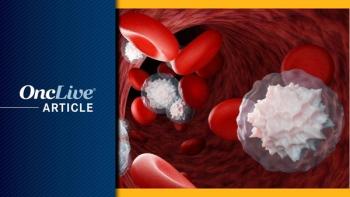
Larotrectinib Continues to Demonstrate High DCR, Elicit Durable Responses in TRK Fusion+ CNS Tumors
Larotrectinib continued to produce rapid and durable responses, with a high disease control rate and an acceptable toxicity profile in patients with TRK fusion–positive, primary central nervous system tumors.
Larotrectinib (Vitrakvi) continued to produce rapid and durable responses, with a high disease control rate (DCR) and an acceptable toxicity profile in patients with TRK fusion–positive, primary central nervous system (CNS) tumors, according to long-term data from 2 clinical trials presented during the 2022 ASCO Annual Meeting.1
Data from the long-term analysis of those treated on the phase 1/2 SCOUT study (NCT02637687) and the phase 2 NAVIGATE study (NCT02576431) showed that larotrectinib elicited an objective response rate (ORR) of 30% (95% CI, 16%-47%). In 28 pediatric patients, the ORR was 39% (95% CI, 22%-59%). The best responses included complete response (CR) in 8% of patients, partial response (PR) in 22%, stable disease (SD) for 24 weeks or more in 43%, SD for less than 24 weeks in 14%, and progressive disease (PD) in 14%.
A DCR for 24 weeks or more was observed in 73% of patients (95% CI, 56%-86%); in adult patients, this rate was 24% (95% CI, 14%-79%) and in pediatric patients, it was 82% (95% CI, 63%-94%). At a median follow-up of 25.6 months, the median DOR was not reached (95% CI, 4.9-not evaluable [NE]). The 24-month DOR was 53% (95% CI, 23%-83%).
Data from SCOUT and NAVIGATE served as partial basis for an accelerated FDA approval granted in 2018 for larotrectinib as treatment of adult and pediatric patients with solid tumors that have a NTRK gene fusion without a known acquired resistance mutation. Larotrectinib can be used in those whose disease is either metastatic or where surgical resection is likely to result in severe morbidity, and who have no satisfactory alternative treatment options or whose cancer has progressed following treatment.
A prior report from these trials showed that larotrectinib achieved an ORR of 30% (95% CI, 16%-49%) and a 24-week DCR of 73% (95% CI, 54%-87%) in 33 evaluable adult and pediatric patients with TRK fusion primary CNS tumors. In addition, treatment with larotrectinib resulted in tumor shrinkage in 82% of patients who had measurable disease.2
The dataset for the long-term analysis included 26 pediatric patients from SCOUT who were under 21 year of age with locally advanced metastatic solid tumors or CNS tumors and 12 adult and adolescent patients from NAVIGATE who were 12 years of age or older with advanced solid tumors and TRK fusion cancer. Collectively, the 38 patients were evaluated for the primary end point of investigator-assessed ORR per RECIST v1.1 criteria. The secondary end points assessed for the long-term analysis included duration of response (DOR), progression-free survival (PFS), overall survival (OS), and safety.
Adult patients were administered oral larotrectinib at 100 mg twice daily, and pediatric patients received 100 mg/m2 twice daily.
Patients enrolled had a median age of 10.8 years (range, 1.3-79.0) and 50% were female. The most common type of NTRK gene fusion identified in patients at baseline was NTRK2 in 74%, followed by NTRK1 in 16%, and NTRK3 in 11%. ECOG performance score ranged from 0 to 2; most patients (53%) had a score of 0, 34% had a score of 1, and 11% had a score of 2.
The majority of patients assessed had high-grade glioma (61%) and low-grade glioma (24%). Sixteen percent of patients had other histologies.
In terms of prior therapies, 71% of patients had undergone surgery, 58% received radiotherapy, and 87% had systemic therapy, and the median number of prior systemic therapies was 1 (range, 0-8). In fact, the majority of patient assessed had a median of 1 prior therapy (42%), whereas 21% had 2, another 21% had 3 or more, and 16% had 0.
On prior therapy, 6% of patient achieved a CR and 3% achieved a PR. The most common response to prior therapy was SD in 36%. Moreover, 30% of patients had PD during prior therapy, and 24% had other responses.
Data from SCOUT and NAVIGATE showed that treatment with larotrectinib lasted for 0.1 months to 38.7 months. The median time to response was 1.9 months (range, 1.0-3.8). Fifty-eight percent of patients progressed on larotrectinib and 4 continued the treatment post-progression for 4 weeks or more.
The median follow-up for PFS assessment was 27.4 months, and larotrectinib achieved a median PFS of 16.5 months (95% CI, 6.7-NE). At 24 months, the PFS rate observed with larotrectinib was 40% (95% CI, 24%-57%). At a median follow-up of 26.7 months, the median OS was not reached (95% CI, 22.6-NE). The 24-months OS rate among the patients evaluated was 65% (95% CI, 47%-83%).
Fifty-five percent of patients in the dataset experienced treatment-related adverse effects (TRAEs), but 86% of them were grade 1 or 2. Eight percent of patients experience grade 3 and 4 TRAEs, which included gamma-glutamytransferase increase, hyperglycemia, hypernatremia, hyponatremia, and neutrophil count decrease. The most common TRAEs of any grade included upper respiratory tract infection, vomiting, diarrhea, alanine aminotransferase increase, headache, anemia, and aspartate aminotransferase increase.
Treatment-related neurologic AEs were also observed in the cohort. Notably, the majority of events were grades 1 and 2 and occurred in the same patients. However, memory impairment was observed in 2 patients, 1 of whom was an adult and other a pediatric patient.
No patients in the study discontinued treatment as a result of a TRAE.
Based on the collective findings, investigators believe that it is important to test for NTRK gene fusions in adult and pediatric patients with primary CNS tumors.
References
- Perreault S, Drilon AE, Lassen LN, et al. Long-term control and safety of larotrectinib in a cohort of adult and pediatric patients with tropomyosin receptor kinase (TRK) fusion primary central nervous system (CNS) tumors. J Clin Oncol. 2022; 40 (suppl 16):2010. doi:10.1200/JCO.2022.40.16_suppl.2010
- Doz F, van Tilburg, Geoerger B, et al. Efficacy and safety of larotrectinib in TRK fusion-positive primary central nervous system tumors. Neuro Oncol. 2022;24(6):997-1007. doi:10.1093/neuonc/noab274

























































































